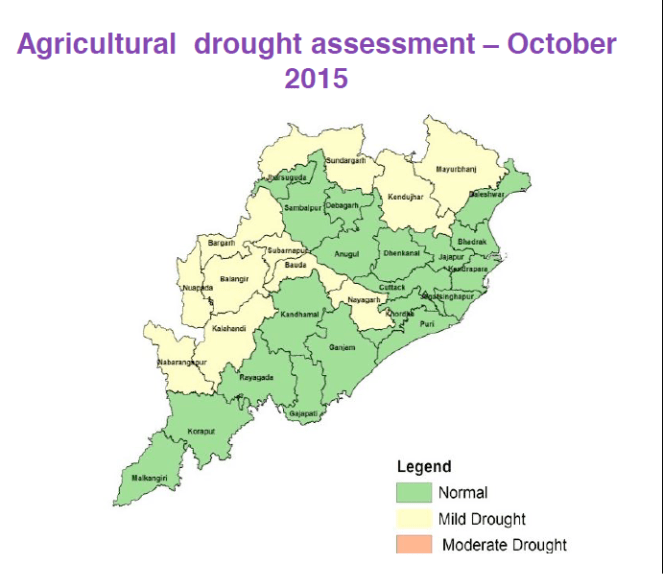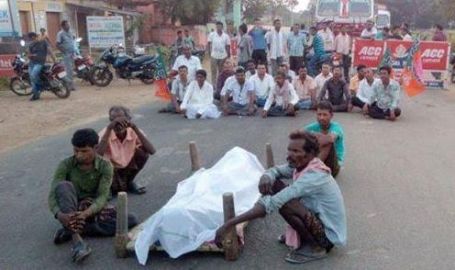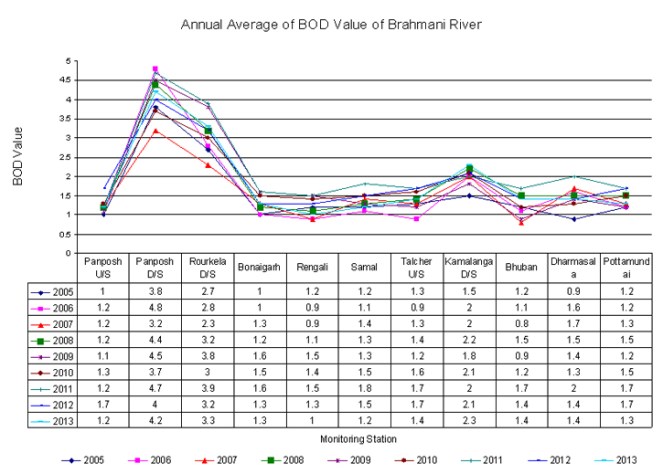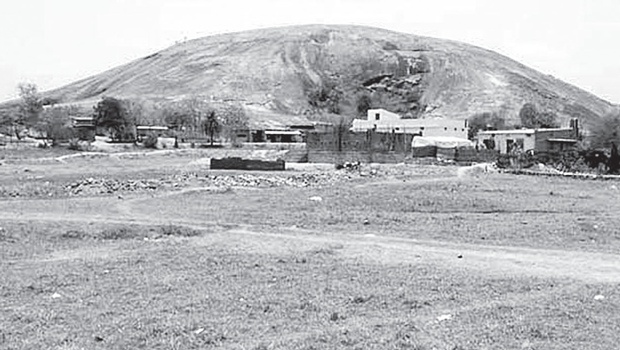Odisha has many rivers, vast forest cover and it receives above average rainfall annually. But, greed for minerals beneath the land and destruction wreaked by industries hungry to exploit the resources of the state have slowly choked the natural environment of the state. Most farm holdings are small or marginal dependent on the rains for irrigation. The deficit rains in 2015-16 pushed the state over the edge. The state is facing extensive crop loss and severe water shortage. Even after exploiting its resources to the hilt, the people of the state have not been provided with piped water supply. In many ways, the drought in Odisha is man made.
A total of 27 out of total of 30 districts have been affected by the drought of 2015-16. The food grain production in the state is likely to drop by more than 43% because of the drought.
Ground water level is going down rapidly due to excessive use for irrigation especially in rain fed Sundargarh and Balasore districts. Thousands of deep borewells are being operated by well-off farmers and also by the Odisha Lift Irrigation Corporation (OLIC). The Rural Water Supply and Sanitation (RWSS) also operates piped water projects using tubewells and deep borewells. Many water bodies have dried up and many have been built over.
The state is heading towards massive degradation of land because of loss of forest lands, agricultural land taken away for other purposes, increase in fallow land and loss of tree cover in plantations. The total degraded land of the state in 2005-2015 is almost 30 per cent of its geographical area.
Decrease in moisture of land led to loss of paddy crop in the state. However, as part of drought relief, the government has again announced to provide pump set and deep bore wells for irrigation. Contrary to logic, on May 5, 2016, the Agriculture Department officials announced a plan to increase cotton cultivation in the upcoming Kharif season. Cotton is known to be a water-guzzling crop.
Since the failure of the Kharif crop, farmers in the state have been in a very critical phase. Many farm areas of the state, especially in western and interior Odisha are rain fed. The damage might have been lesser if the areas had irrigation facilities. Lack of irrigation leaves the farmers in distress when the monsoon is deficient or even if the rains are unevenly distributed. Most farmers skipped the Rabi crop because of lack of water in reservoirs and canals.
Agrarian crisis – Crop loss, indebtedness leading to suicides and migration

On Oct 29, 2016, the Special Relief Commissioner of the state informed that the government had received 41 reports of farmer suicides from across the state. An inquiry into the suicides reported “mainly family disputes and excessive liquor consumption” for causing the deaths of the farmers. The Odisha government refused to link the suicides to crop failure. By mid March 2016, the official number of farmer suicides since the kharif season of 2015 had gone up to 174. However, the government continued to insist that none of the suicides was linked to crop loss and they were due to causes like illness, heart attack, mental disturbance, drug addiction and family quarrel.
Failure of crops due to drought and growing indebtedness are the main reasons for farmer distress.
Over 3600 farmers have committed suicide in Odisha between 1999 and 2013. Farm distress in Odisha worsened this year after the kharif crop was severely impacted by scanty rainfall in July and August. According to the official records, crop area of 21.6 lakh ha is affected, out of which at least 14.82 lakh ha in 233 blocks in 27 districts have suffered losses over 33%. The worst affected district is Mayurbhanj followed by Bargarh, Balangir, Keonjhar and Nayagarh districts.
Unlike suicides in Karnataka, Andhra Pradesh, Telangana and Maharastra that are known to be related to cash crops such as sugarcane and cotton, Odisha farmers mainly grow paddy and the suicides have been by paddy cultivators. Yet indebtedness is one of the major reasons behind farmer suicides. Moneylenders charge rates of interest as high as 25-40% and shame the indebted farmers publicly on failing to repay; the loss of self-esteem often pushes the farmer to take his life. Most of them had taken loans from private and non-government agencies without access to bank or cooperative loans.
Suicides have been reported from across the state, but a large percentage (70% as of Nov 2015) occurred in the western Odisha districts such as Bolangir, Nuapada and Sambalpur and the maximum, 26 at Bargarh. Western Odisha districts lack irrigation facilities. Erratic monsoon destroys the crop leaving the farmer with nothing for sustenance and a mountain of debt that he is unable to repay.

Farmers’ suicide cases spread throughout western Odisha
Most of the farmers committing suicide were marginal farmers and sharecroppers. Because the Orissa Land Reforms Act, 1974 explicitly bans tenancy, sharecroppers don’t get any benefits such as compensation or relief announced for farmers which goes directly to the landlords. Tenants cultivating the agricultural land on lease cannot access loans through credit institutions or insurance and other support services provided by the Government. They are not assured of the Minimum Support Price (MSP) without the farmer’s Identity card and remain at the mercy of middlemen and the corrupt procurement agencies.
Fearing inability to repay private moneylenders after deficit rainfall, farmers of rainfed and drought areas of western Odisha were reportedly falling into the clutches of labour sardars in Sep 2015. By the end of Feb 2016, over 30,000 people had migrated from Kalahandi, Nuapada and Bolangir district. Many migrated to neighbouring states as labourers to work in brick kilns. Delayed payment of wages and insufficient employement kept people from working under NREGA.
Pollution, Industrialization, Ecological damage
Odisha has ignored the farm sector and has welcomed industries and mining companies to the state without proper checks and balances in place. In many cases it has given away water resources to industries at the expense of farmers and drinking water needs of village. Over exploitation of water resources and spoilage of rivers and land by industries and mining has contributed to the scarcity of fresh water during the current drought.
On Feb 26, 2016, the state government brought out a guideline allowing diversion of irrigated command area for the purpose of industrialization. The concerned industry can make up for the loss by bearing the cost of creating compensatory irrigation. Activists said that the guideline would open the floodgate for proposals of acquiring irrigated land. At a time when impact of drought is getting worse due to absence of assured irrigation, the diversion of irrigated land would spell doom for farmers. Indeed this is most objectionable and against the rights of farmers and also national water policy.
The civil society of Balasore has been opposing a project sanctioned by the Industrial Infrastructure Development Corporation (IDCO) to draw water from Budhabalanga and Sono rivers to supply to industries. Massive amounts of water drawn by industries would make water scarce for human and agricultural use and could lead to ecological disturbances.
Groundwater and surface water are being exploited excessively for commercial, agricultural and domestic purposes in the industrial and mining district of Sundargarh. About 60 industries have taken licences to use ground and surface water. Unauthorised packaged water supply plants are also drawing water.

Source CBCP
The Brahmani, Odisha’s second-largest river, is the state’s most polluted because of excessive hexavalent chromium (a carcinogen) – a fact admitted by the state pollution control board itself. Heavy mining for Chromite ore in Sukinda valley in Jajpur district over 70 years has contaminating the river water. Surveys have indicated that chromite-related diseases caused more than 80% deaths in heavily mined areas.
The Brahmani River has been further polluted by industrial waste in Dhenkanal district. Several diseases have afflicted the people and livestock on the banks in the district that depend on the river for water for domestic use.
On May 5 2016, villagers in Dhenkanal district complained against illegal use of river and ground water and also discharge of industrial pollutant in the water course by a company in the vicinity causing severe water scarcity in the area.
There have been no efforts to arrest exploitation of water resources, recharge them or prevent their spoilage – all of which have been revealed to be direly needed by the crisis emerging from the current drought.
Failure of rural and urban water supply and drinking water scarcity
Rising temperatures have dried up surface water sources. Ground water levels have been falling rapidly because of which many tubewells across the state are lying defunct.
Hundreds of families are dependent on 1 or 2 tubewells in some villages in districts such as Balangir. In many water stressed areas, tube well water is laced with minerals. Villagers in Nuapada district are consuming water from tubewells marked for having fluoride beyond permissible limits.

People colleting water from a standpost in Turekela village
Villagers in Dhenkanal district staged a road blockade protesting water shortage. RWSS water projects in the villages are defunct and tankers are failing to meet the demand.
In all these places, the people have no alternative, as piped water supply has not been provided by the state. Rural water supply infrastructure is lying defunct for a range of reasons such as no power supply, disrupted power supply due to non-payment of dues or shortage of staff. Work on new projects and repair of defunct projects has not started due to want of funds. Where funds have been release by the state government, work is suspended due to lack of coordination among panchayat officials and block authorities.
Reservoirs have also dipped causing water shortages in areas where they supplied water. Reports of acute water crisis from Rayagada, Kalahandi and Ganjam districts.
Urban water supply is also dismal. Last year, the CAG found that Odisha was unable to supply adequate drinking water to people in 95 out of 106 urban areas. This year, the water supply is only worse.
The drought has increased migration to slums in the city from rural areas worsening the shortage. Parts of Bhubaneshwar saw a jaundice outbreak in March 2016 due to contaminated drinking water. In Keonjhar, two children allegedly died after drinking contaminated water. Rourkela is facing a water crisis since mid-April after the river Koel, the city’s only source of water dried up. In Apr 2016, Paradip reported an acute drinking water shortage, especially in the slums housing half the town’s population. Companies have overexploited groundwater. Water tankers have been deployed but they have not been enough. Making matters worse, people are struggling with the water crisis in the middle of an intense heatwave.
Water supply project works flagged off in cities such as Rourkela, Sonepur, Jambhira are pending even while the people are facing acute water crisis. The CAG audit found that water supply works have remained incomplete even after 47 months of their starting. The state has not utilized 70% of the central fund in time. However the Odisha government has blamed the Centre for drastically cutting assistance for drinking water supply schemes. In 2014-15, the Centre had provided Rs 230.66 crore financial assistance under NRDWP. However, the assistance was reduced to Rs 89 crore in 2015-16 and an estimated Rs 24 crore in 2016-17.
Rainfall:
While the state experienced surplus rainfall in June, rainfall was deficient in July-October. The State experienced prolonged dry spells during the months of South West monsoons.
| Month | Rainfall in mm | Deviation in % | |
| Normal | Actual | ||
| June | 216.5 | 234.6 | 8.4 |
| July | 339.9 | 308.4 | -9.3 |
| August | 356.0 | 266.5 | -25.1 |
| September | 231.9 | 221.5 | -4.5 |
| October | 114.7 | 25.3 | -77.9 |
Source: Drought report of the state government
District wise rainfall status (Jun 1 2015 to Sept 30 2015)
| District | SW Monsoon Deviation from normal |
| Angul | -20% |
| Balasore | -13% |
| Bargarh | -19% |
| Bhadrak | -18% |
| Bolangir | -27% |
| Boudhgarh | -13% |
| Cuttack | -14% |
| Deogarh | -18% |
| Dhenkanal | -20% |
| Gajapati | -10% |
| Ganjam | -4% |
| Jagatsinghpur | -13% |
| Jajpur | -17% |
| Jharsuguda | 7% |
| Kalahandi | -12% |
| Kandhamal | -31% |
| Kendrapara | -13% |
| Keonjhar | -21% |
| Khurdha | -28% |
| Koraput | 4% |
| Malkangiri | 45% |
| Mayurbhanj | -16% |
| Nabarangpur | 9% |
| Nayagarh | -19% |
| Nuapada | 2% |
| Puri | -23% |
| Rayagada | -4% |
| Sambalpur | -13% |
| Subarnapur | -29% |
| Sundargarh | -1% |
Source: IMD
Blockwise rainfall: http://as.ori.nic.in/balangir/rainfall/login.asp
Reservoir Status (as of Apr 28, 2016; The average of last 10 years is taken as ‘normal’; Source: CWC)
| Reservoir | Storage in % of live capacity at FRL | ||
| Current | Last year | Normal | |
| Hirakud | 32 | 29 | 34 |
| Balimela | 37 | 54 | 26 |
| Salanadi | 4 | 39 | 26 |
| Rengali | 26 | 63 | 30 |
| Machkund | 42 | 39 | 44 |
| Upper Kolab | 29 | 52 | 30 |
| Upper Indravati | 34 | 50 | 29 |
Salanadi reservoir has only 14% of normal storage.
Mar 28, 2016: Live storage capacity of Odisha’s large and medium reservoirs dropped from 87.3% to 68.9% of full reservoir level during the past 10 years. Some of the medium reservoirs are likely to become dead in the near future. Reservoirs with reduced water-holding capacity were of little help in providing irrigation water to fields at several places during the 2015 drought.
River Basins (as of Apr 28 2016; Source: CWC)
Water levels (in BCM) in river basins:
Mahanadi and other east flowing: 13.181 (full reservoir level); 6.454 (April 2015); 3.977(April 2016); 17.81% below normal
NREGA
- Sept 20, 2015: The State Government on Saturday decided to provide 200 days of work under MGNREGA in drought hit areas to prevent migration of people. It came two days after the Centre announced 150 days of work under MGNREGA in drought hit areas across the country. State Government will bear the additional expenditure to be incurred for extension of 150 days’ work to 200 days.
- As of Dec 1, 2015, only 276 households in the drought-hit blocks had been provided 150 days of work. Not a single household had got 150 days of work in Bargarh district which saw the most farmer suicides.
- Jan 8, 2016: At present, Odisha has a negative balance of MGNREGA funds for the current financial year, resulting not only in pending payment of wages of workers but also allegedly leading to denial of jobs to many in need, thus threatening the very nature of the demand-based legal employment guarantee of the scheme.
- As of Jan 25, 2016 January, only 4.6% of rural households in Odisha, had availed 100 days of employment under NREGA in 2015-16.
- Apr 3, 2016: NREGA daily wage remains at Rs 174. This is despite Odisha government’s request to the Centre to raise it at least to Rs 200 per day. With the state facing a drought, CM Naveen Patnaik had in November last year written to Prime Minister Modi requesting him to increase the MGNREGA wages to Rs 200, which was the minimum wage in the state for unskilled labour.
NREGA statistics based on data from http://nrega.nic.in/
- In 2015-16, close to 90% of the households that demanded employment were employed. But the average number of days of employment in the year was only 44.64 days. Only 9% of the households that got employment were employed for more than 100 days although the limit had been extended to 200. There was a surge in demand for employment after December 2015.
- Amount over Rs. 93 crore is unpaid from NREGA wages for 2015-16 and the total NREGA expenditure from 2015-16, which has not been paid yet, is over Rs 231 crore.
- In the financial year 2015-16, the expenditure in wages was 77% of the total expenditure of Odisha on NREGA.
Government Action
Centre:
- Jan 7, 2016: Centre allocated Rs 815 crore for Odisha for drought relief. A senior officer in Revenue department said on Feb 18, 2016 that till date not a single rupee has been released for the purpose.
- Mar 31 2016: Odisha received Rs.276.54 crore central assistance towards drought. The ruling BJD government alleged that poll-bound states had received much more assistance in comparison. Credence is lent to that claim by the fact that in Feb 2016, Rs 1,737.65 crore was approved for drought relief for Tamil Nadu which had not even declared drought.
State:

Dry bed of Swajaldhara project in Rangeilunda block in Ganjam district
- Oct 15, 2015: The Odisha government declared 16 districts in the state as drought affected. (Later on, more districts were declared drought hit bringing the total number to 27 districts.) The government declared a Rs 1,000 crore package for drought-affected farmers. Input subsidy was promised to be provided at the rate of Rs 6,800 per hectare in rain-fed areas, and Rs 13,500 per hectare in irrigated areas. Drought affected farmers would be provided loans for Rabi crop. It also included relaxation in the repayment of agricultural loan and subsidised food for affected farmers for two months.
- Nov 19, 2015: The CM announced a series of measures to tackle the drought. He announced crop loan at 1% interest and a provision of drought assistance of Rs 100 per quintal of paddy for affected peasants in 21 districts. Work for the mega lift irrigation project near Indravati river in Kalahandi district would begin within 15 days. He also announced Aung Medium Irrigation Project worth Rs 1500 crore and Jeera Medium Irrigation Project (Rs 300 crore) to enhance the irrigation potential in Bargarh district.
- In Mar 2016, the CAG reported that farmers were deprived of timely compensation for crop loss due to natural calamities in 2010 and 2013 as the government delayed assessment. Likewise, farmers will get compensation and crop insurance for the current drought only when crop cutting reports come in while immediate relief is what is needed to prevent distress migration and further suicides.
- Apr 8, 2016: The state government cut the quantum of water allocated originally to Jindal Stainless Ltd (JSL), NTPC Ltd and Jindal Steel & Power Ltd (JSPL) to conserve water. Water allocation has been scrapped to some projects that haven’t started or have delayed a lot.
- Apr 19 2016: The Odisha Government announced that it would continue mid-day meal scheme in the drought affected 27 districts through the summer holidays.
- The forest officials of Sundargarh district have been working for the preceding 3 years to set up and renovate water bodies in forest areas to provide for the wild animals through the hot season.
- The government had submitted a memorandum to the centre demanding Rs 2,344.99 crore for drought relief. Officials claimed that Rs.333 crore had been disbursed to 7.87 lakh drought-affected farmers as of May 2016.
Anuradha UV, SANDRP (uv.anuradha@gmail.com)
Also may also like to see

Very good analysis on drought situation in Odisha-2016
LikeLike
Such an ethical analysis of the view of drought in Odisha 2015. It may make an overview towards the agricultural development.
Because of the Drought situation faced, Odisha’s GSDP(Gross State Domestic Product) decrease almost 40 percent of previous year’s GSDP. Authority should take more action in favor of agricultural development.Odisha’s economic status mainly dependent on agriculture and maximum people of Odisha engage in the agricultural sector.
LikeLike